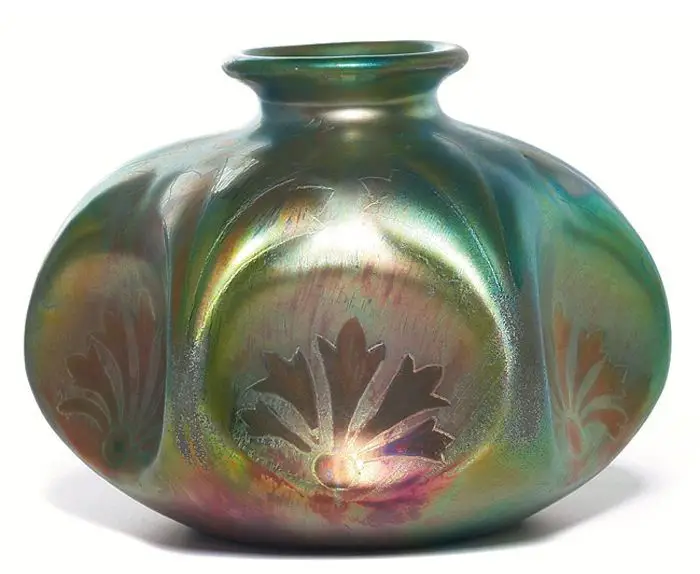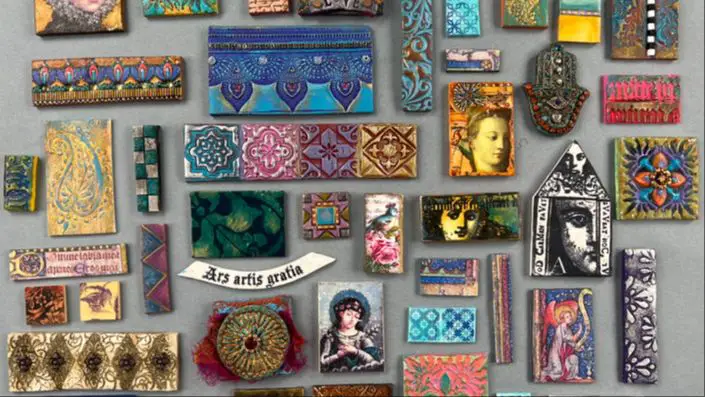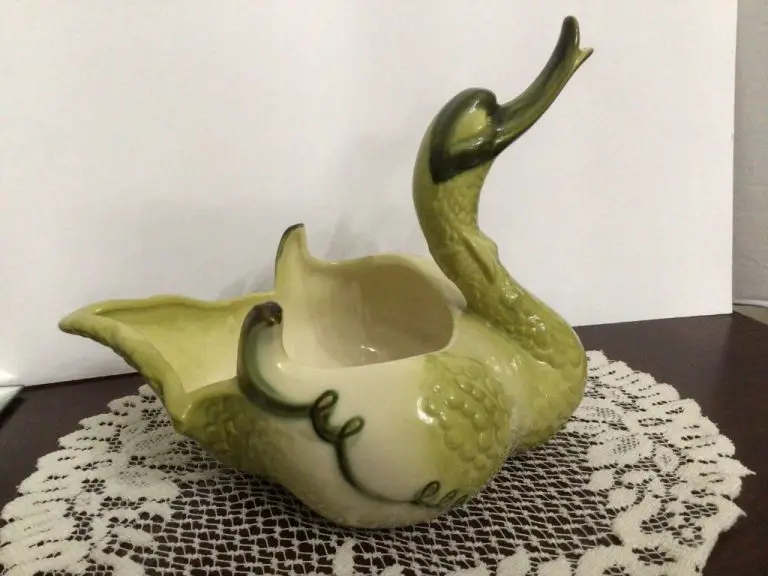What Is Rookwood Pottery Known For?
Rookwood Pottery is an American ceramic company that was founded in 1880 in Cincinnati, Ohio by Maria Longworth Nichols. The company started out producing architectural faience and ceramic tiles, but soon shifted focus to producing art pottery.
Rookwood became known for its innovative glazes and production techniques, helping establish American art pottery on the global stage. The company was influential in developing new colors, glazes, and firing methods that transformed the American pottery industry. Some of Rookwood’s major innovations included discovering how to produce a quality matte glaze, developing the first production matte glazes in the US, and pioneering special processing techniques like electroplating and carved decoration [1].
Artistic Style
Rookwood Pottery is known for its unique decorative and ornamental style that was influenced by the Arts and Crafts movement. According to the Rookwood website, “Rookwood’s artistic fame is based on its innovated glazes and pioneering ceramic arts” (https://rookwood.com/pages/about-rookwood). The pottery often features floral motifs and designs inspired by nature.

As described on Just Art Pottery, “Rookwood wares feature rich earthy glazes often accented with raised areas of white clay slip trailing and ornamental decorative motifs” (https://justartpottery.com/pages/about-rookwood-pottery). This ornamental style aligned with the Arts and Crafts preference for handcrafted decorative objects.
Notable Artists
Rookwood Pottery was founded by Maria Longworth Nichols Storer in 1880. Maria was an avid collector of pottery from Japan and Cincinnati’s art museum. She wanted to start a pottery that created artistic wares in Cincinnati. Maria led operations, recruited artists, and helped formulate innovative glazes in Rookwood’s early years.[1]
William McDonald was Rookwood’s first art director, from 1886 to 1928. He helped establish Rookwood as a premier American art pottery through his impressive modeling skills and artistic vision. McDonald created many acclaimed vases and sculptures.[2]
Kataro Shirayamadani was a prominent Japanese ceramic artist at Rookwood. He joined in 1891 and brought knowledge of Eastern techniques in glazing and firing. Shirayamadani’s expertise with crystalline glazes led to some of Rookwood’s most striking glaze effects.
[1] https://www.thekingsfortune.com/rookwood-pottery-artists-and-marks
Innovations in Glazes
Rookwood Pottery was a pioneer in matte glazes. While most American potteries used high gloss glazes to mimic fine Chinese porcelain in the late 1800s, Rookwood intentionally developed revolutionary matte glazes with a soft, velvety appearance. These matte glazes became a signature of Rookwood Pottery, helping distinguish it from competitors. Rookwood was also an innovator in glaze production methods, utilizing both mass production and artisanal techniques to create vibrant, colorful glazes (rookwood.com).
Perhaps Rookwood’s most iconic glaze is the IRIS glaze, known for its iridescent rainbow-like coloring. First developed in the early 1900s, IRIS glaze was difficult to produce consistently. Rookwood perfected both the composition and production method for IRIS glaze, allowing them to offer this prized glaze on production pieces (rookwood.com). The IRIS glaze exemplifies Rookwood’s mastery of both artistry and manufacturing.
Types of Wares
Rookwood is known for producing many types of ceramic wares, but some of their most famous include:[1]
Vases
Rookwood produced stunning American Art Nouveau vases with beautiful glazes starting in the late 1800s. Many featured stylized floral and botanical motifs. Some of their most prized vases were produced by famous Rookwood artists like Kataro Shirayamadani.
Jardinieres
Rookwood jardinieres were decorative containers used to hold plants. They were produced in varied shapes and sizes and often featured striking matte glazes in earthy tones. Many were molded with Art Nouveau inspired floral and plant motifs.
Lamps
Rookwood created exceptional lamps starting in the early 1900s during the American Arts and Crafts era. The lamp bases featured molded imagery of nature like trees, leaves, birds and landscapes. They exemplified the simplicity and handcrafted beauty of Arts and Crafts style.
Tiles
Intricate tilework was another Rookwood specialty. They produced tiles with colorful glazes in geometric, floral and nature designs. Rookwood architectural tiles can be found decorating fireplace surrounds, backsplashes, murals and more. They are cherished for their artistry and craftsmanship.
[1] https://rookwood.com/pages/about-us
Awards and Recognition
Rookwood Pottery is widely acclaimed for its artistry and innovation in ceramic glazes and techniques. Some of its most notable achievements include:
Rookwood won grand prizes for architectural faience at the World’s Columbian Exposition in Chicago in 1893 and the Pan-American Exposition in Buffalo in 1901. These World’s Fair awards brought international recognition to Rookwood’s mastery of ceramic arts https://thepotterywheel.com/the-history-of-rookwood-pottery/.
Many pieces by Rookwood artists are represented in major museum collections, including the Metropolitan Museum of Art, Smithsonian American Art Museum, and Cincinnati Art Museum. Rookwood wares are prized for their innovative glazes and techniques.
The Rookwood Pottery Factory was designated a National Historic Landmark in 1993 in recognition of its significance as a pioneering American art pottery. This honor cements Rookwood’s legacy and influence on American decorative arts.
Identifying Marks
Rookwood Pottery developed a system of identifying marks that can help date and attribute pieces. There are three main types of marks to look for:
The impressed RP logo was used from 1886 to 1962. This stamp indicates the piece was made at the Rookwood Pottery studio in Cincinnati. According to the Rookwood Pottery Database, “On some very early pieces the RP mark may be absent, since it took a short time for the newly reorganized pottery to implement all its markings.” 1
Date cyphers were special symbolic markings used to date pieces, typically found alongside the RP logo. The cyphers changed periodically, allowing collectors to date pieces based on the cypher. For example, “a piece marked with the Impressed RP logo and the Roman Numeral XII was made in 1912.” 2
Artist monograms were the personal ciphers of individual Rookwood artists. Monograms signatures “are either incised in the pottery or inked under the glaze.” Recognizing an artist’s personal style or monogram can help attribute pieces. However, many pieces lack artist signatures. 1
Current Status
Rookwood Pottery continues operations today, although production has scaled back from its heyday in the early 1900s. After peaking in the 1930s, output was reduced as the company struggled during World War II. Rookwood relocated its headquarters and main production facility several times throughout the mid-1900s, settling in Oxford, Ohio in 1967.
Over the years, Rookwood was acquired by other companies looking to capitalize on its famous brand name. Today it operates as part of the Ceramic Art Company group. While no longer producing the huge volumes it once did, Rookwood still makes pottery utilizing the techniques, glazes, and artistic styles it pioneered over a century ago.
Some of Rookwood’s most collectible and valuable pieces date from its turn-of-the-century period under the direction of Maria Longworth Nichols. But the company’s storied legacy and continued production ensure that Rookwood Pottery remains a relevant name in the studio art pottery world.
Cultural Significance
Rookwood Pottery had a major contribution to American art pottery in the late 19th and early 20th centuries. Founded in 1880 in Cincinnati, Ohio, Rookwood reflected the Arts and Crafts aesthetic that was popular at the time and pioneered new artistic glazing techniques. Many renowned artists worked at Rookwood, creating unique and valuable works of art pottery.
Today, Rookwood pottery is highly collectible and valuable as an important part of America’s artistic heritage. Its pieces from the height of production in the 1890s-1920s are sought after by museums and collectors. Rookwood ceramics from this era can sell for thousands of dollars at auction. The company persists today, producing new works that carry on the Rookwood tradition and legacy as pioneers of American art pottery.
Conclusion
Rookwood Pottery began in 1880 and quickly became known for its beautiful glazes and artistic sensibilities. Over the years, Rookwood employed innovative ceramic artists who pioneered new techniques in glazing. The company produced high quality decorative pottery and architectural tiles that won awards and acclaim at expositions and fairs.
Rookwood left a lasting legacy on American ceramic arts. Its artistic pottery expanded the possibilities of the medium and elevated ceramic art to new heights. Rookwood pieces are now prized works collected by museums and collectors around the world. The company’s innovations and artistry helped shape the American art pottery movement at the turn of the 20th century.





